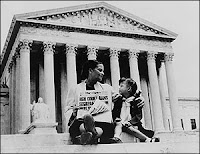
How do you think the students would have reacted to the busing with out pressure from their parents or the presence of the media? Please answer in the comments section.
Dialogue, Readings and Assignments for Lexington High School's course


 On the eve of the 50th anniversary of the landmark case, "Brown vs. the Board of Education", many scholars, writers, and educators published works examining the legacies of the case as well as reflections about the desegregation and integration process.
On the eve of the 50th anniversary of the landmark case, "Brown vs. the Board of Education", many scholars, writers, and educators published works examining the legacies of the case as well as reflections about the desegregation and integration process. t they did know the name of their president. In the days and weeks after May 17, 1954, Americans by the hundreds wrote to tell Dwight D. Eisenhower what they thought about the ruling.
t they did know the name of their president. In the days and weeks after May 17, 1954, Americans by the hundreds wrote to tell Dwight D. Eisenhower what they thought about the ruling.

"Twas down in Mississippi no so long ago,
When a young boy from Chicago town stepped through a Southern door.
This boy's dreadful tragedy I can still remember well,
The color of his skin was black and his name was Emmett Till.
Some men they dragged him to a barn and there they beat him up.
They said they had a reason, but I can't remember what.
They tortured him and did some evil things too evil to repeat.
There was screaming sounds inside the barn, there was laughing sounds out on the street.
Then they rolled his body down a gulf amidst a bloody red rain
And they threw him in the waters wide to cease his screaming pain.
The reason that they killed him there, and I'm sure it ain't no lie,
Was just for the fun of killin' him and to watch him slowly die.
And then to stop the United States of yelling for a trial,
Two brothers they confessed that they had killed poor Emmett Till.
But on the jury there were men who helped the brothers commit this awful crime,
And so this trial was a mockery, but nobody seemed to mind.
I saw the morning papers but I could not bear to see
The smiling brothers walkin' down the courthouse stairs.
For the jury found them innocent and the brothers they went free,
While Emmett's body floats the foam of a Jim Crow southern sea.
If you can't speak out against this kind of thing, a crime that's so unjust,
Your eyes are filled with dead men's dirt, your mind is filled with dust.
Your arms and legs they must be in shackles and chains, and your blood it must refuse to flow,
For you let this human race fall down so God-awful low!
This song is just a reminder to remind your fellow man
That this kind of thing still lives today in that ghost-robed Ku Klux Klan.
But if all of us folks that thinks alike, if we gave all we could give,
We could make this great land of ours a greater place to live.
Copyright ©1963; renewed 1991 Special Rider Music
